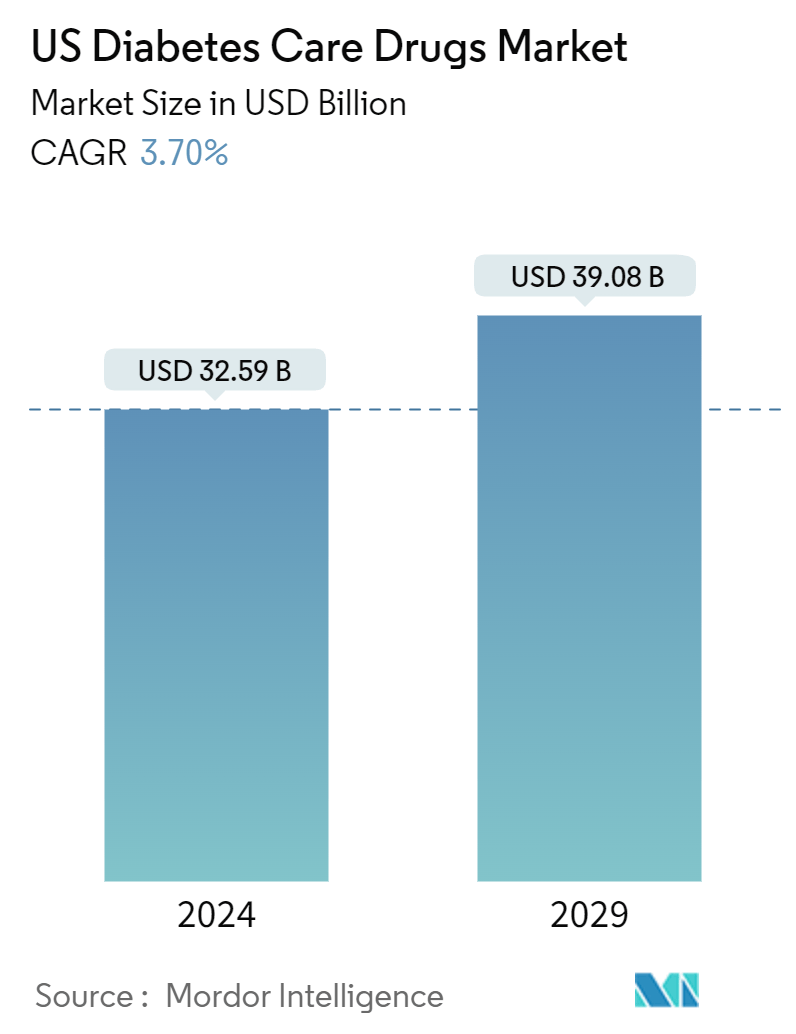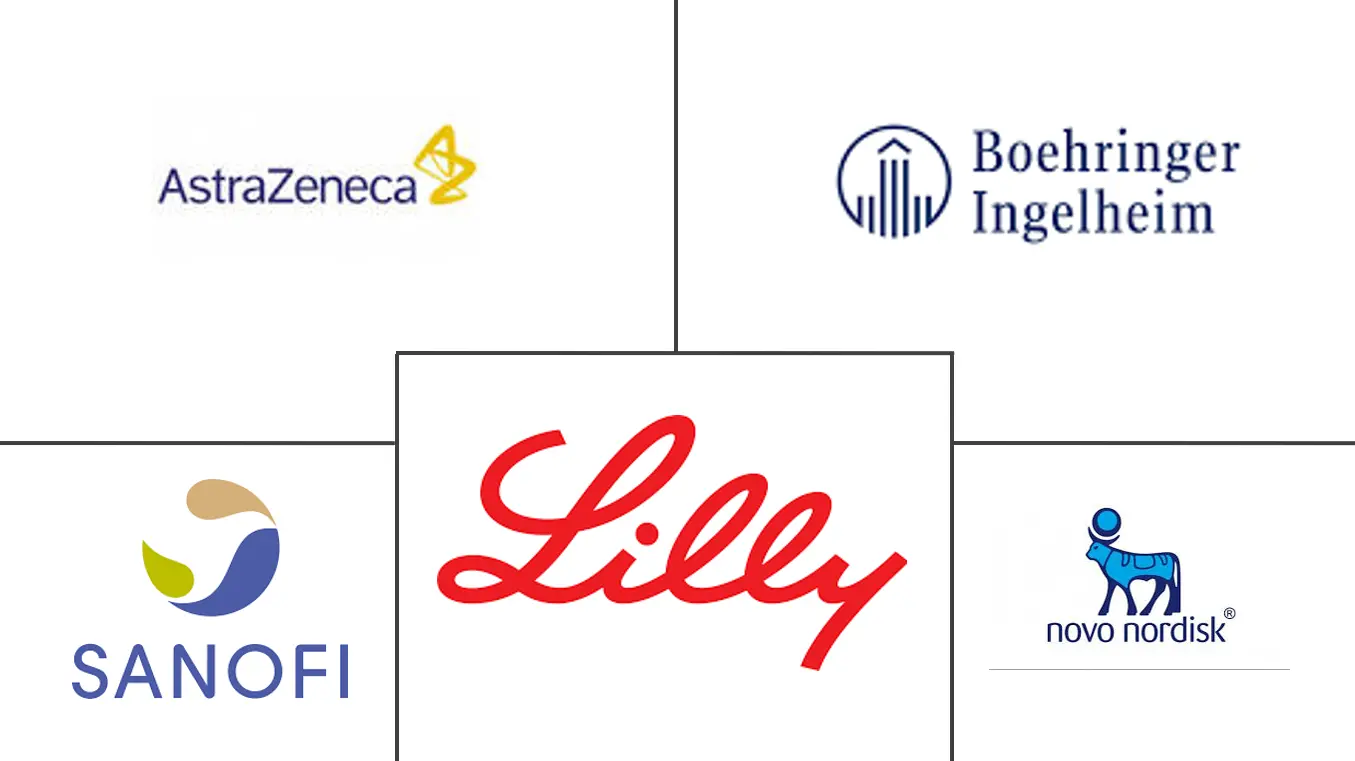Market Size of US Diabetes Care Drugs Industry

| Study Period | 2019 - 2029 |
| Base Year For Estimation | 2023 |
| Forecast Data Period | 2024 - 2029 |
| Market Size (2024) | USD 32.59 Billion |
| Market Size (2029) | USD 39.08 Billion |
| CAGR (2024 - 2029) | 3.70 % |
Major Players
*Disclaimer: Major Players sorted in no particular order |
US Diabetes Care Drugs Market Analysis
The US Diabetes Care Drugs Market size is estimated at USD 32.59 billion in 2024, and is expected to reach USD 39.08 billion by 2029, growing at a CAGR of 3.70% during the forecast period (2024-2029).
The prevalence of diabetes in the United States is rapidly increasing, as indicated by the latest data from the CDC's National Diabetes Statistics Report for 2022. The report estimates that there are now approximately 37.3 million cases of diabetes in the country. This accounts for 11.3% of the U.S. population.
Out of these cases, around 28.7 million individuals have already been diagnosed with diabetes, while approximately 8.6 million people remain undiagnosed. It is important to note that diabetes affects individuals from all social, economic, and ethnic backgrounds. Furthermore, nearly half of the population aged 65 years or older, which amounts to 26.4 million people, have prediabetes.
According to the World Health Organization (WHO), the risk of diabetes has increased in North America due to the aging population. With advancements in healthcare, people are living longer, resulting in a significant percentage of the aging population being diagnosed with diabetes. The rising number of diabetes cases includes individuals who have recently developed the condition, particularly young individuals with unhealthy lifestyles. Additionally, there is an increase in the number of older adults who have been diagnosed with diabetes due to the availability of newer tests and increased screening.
Based on drugs, the insulin segment holds a significant share in the market. Over 100 million people around the world need insulin, including all the people suffering from Type-1 diabetes and between 10% and 25% of people with Type-2 diabetes. Production of insulin is very complex, and there are very few companies in the market that manufacture insulin. Due to this, there is high competition between these manufacturers, who always strive to meet the patient's needs to supply the best-quality insulin.
US Diabetes Care Drugs Industry Segmentation
Diabetes or diabetes mellitus describes a group of metabolic disorders characterized by a high blood sugar level in a person. With diabetes, the body either does not produce enough insulin or the body's cells do not respond properly to insulin, or both. The United States diabetes care drugs market is segmented into drugs. The report offers the value (in USD) and volume (in Units) for the above segments.
| Oral Anti-diabetic drugs | ||||||
| ||||||
| ||||||
| ||||||
| ||||||
| ||||||
| ||||||
|
| Insulins | |||||||
| |||||||
| |||||||
| |||||||
|
| Combination drugs | |||||
| |||||
|
| Non-Insulin Injectable drugs | |||||||
| |||||||
|
US Diabetes Care Drugs Market Size Summary
The US diabetes care drugs market is poised for significant growth, driven by the increasing prevalence of diabetes across diverse demographics. The market is characterized by a robust demand for insulin and oral anti-diabetes medications, with insulin holding a substantial share due to its critical role in managing Type 1 and a portion of Type 2 diabetes cases. The complexity of insulin production and the limited number of manufacturers contribute to a competitive landscape, where companies strive to meet the high demand for quality insulin. Meanwhile, the oral anti-diabetes drugs segment, led by Metformin, is expected to expand, fueled by its widespread use and favorable risk/benefit profile. Metformin's long-term efficacy, safety, and cost-effectiveness have cemented its position as the most prescribed oral antidiabetic drug globally.
The United States stands as a dominant force in the global insulin therapeutics market, attributed to its high diabetes prevalence and the introduction of new drugs. The market's growth is further supported by increasing awareness of diabetes care and the high demand for diabetic drugs to stabilize blood glucose levels. Recent regulatory approvals, such as those for Empagliflozin and Metformin Hydrochloride tablets, underscore the ongoing innovation and expansion within the market. Additionally, advancements in treatment options, including the approval of Lantidra for Type 1 diabetes and new oral medications for pediatric patients, highlight the dynamic nature of the industry. These factors collectively contribute to the anticipated growth of the US diabetes care drugs market over the forecast period.
US Diabetes Care Drugs Market Size - Table of Contents
-
1. MARKET DYNAMICS
-
1.1 Market Overview
-
1.2 Market Drivers
-
1.3 Market Restraints
-
1.4 Porter's Five Forces Analysis
-
1.4.1 Bargaining Power of Suppliers
-
1.4.2 Bargaining Power of Consumers
-
1.4.3 Threat of New Entrants
-
1.4.4 Threat of Substitute Products and Services
-
1.4.5 Intensity of Competitive Rivalry
-
-
-
2. MARKET SEGMENTATION
-
2.1 Oral Anti-diabetic drugs
-
2.1.1 Biguanides
-
2.1.1.1 Metformin
-
-
2.1.2 Alpha-Glucosidase Inhibitors
-
2.1.2.1 Alpha-Glucosidase Inhibitors
-
-
2.1.3 Dopamine D2 receptor agonist
-
2.1.3.1 Bromocriptin
-
-
2.1.4 SGLT-2 inhibitors
-
2.1.4.1 Invokana (Canagliflozin)
-
2.1.4.2 Jardiance (Empagliflozin)
-
2.1.4.3 Farxiga/Forxiga (Dapagliflozin)
-
2.1.4.4 Suglat (Ipragliflozin)
-
-
2.1.5 DPP-4 inhibitors
-
2.1.5.1 Onglyza (Saxagliptin)
-
2.1.5.2 Tradjenta (Linagliptin)
-
2.1.5.3 Vipidia/Nesina(Alogliptin)
-
2.1.5.4 Galvus (Vildagliptin)
-
-
2.1.6 Sulfonylureas
-
2.1.6.1 Sulfonylureas
-
-
2.1.7 Meglitinides
-
2.1.7.1 Meglitinides
-
-
-
2.2 Insulins
-
2.2.1 Basal or Long Acting Insulins
-
2.2.1.1 Lantus (Insulin Glargine)
-
2.2.1.2 Levemir (Insulin Detemir)
-
2.2.1.3 Toujeo (Insulin Glargine)
-
2.2.1.4 Tresiba (Insulin Degludec)
-
2.2.1.5 Basaglar (Insulin Glargine)
-
-
2.2.2 Bolus or Fast Acting Insulins
-
2.2.2.1 NovoRapid/Novolog (Insulin Aspart)
-
2.2.2.2 Humalog (Insulin Lispro)
-
2.2.2.3 Apidra (Insulin Glulisine)
-
-
2.2.3 Traditional Human Insulins
-
2.2.3.1 Novolin/Actrapid/Insulatard
-
2.2.3.2 Humulin
-
2.2.3.3 Insuman
-
-
2.2.4 Biosimilar Insulins
-
2.2.4.1 Insulin Glargine Biosimilars
-
2.2.4.2 Human Insulin Biosimilars
-
-
-
2.3 Combination drugs
-
2.3.1 Insulin combinations
-
2.3.1.1 NovoMix (Biphasic Insulin Aspart)
-
2.3.1.2 Ryzodeg (Insulin Degludec and Insulin Aspart)
-
2.3.1.3 Xultophy (Insulin Degludec and Liraglutide)
-
-
2.3.2 Oral Combinations
-
2.3.2.1 Janumet (Sitagliptin and Metformin)
-
-
-
2.4 Non-Insulin Injectable drugs
-
2.4.1 GLP-1 receptor agonists
-
2.4.1.1 Victoza (Liraglutide)
-
2.4.1.2 Byetta (Exenatide)
-
2.4.1.3 Bydureon (Exenatide)
-
2.4.1.4 Trulicity (Dulaglutide)
-
2.4.1.5 Lyxumia (Lixisenatide)
-
-
2.4.2 Amylin Analogue
-
2.4.2.1 Symlin (Pramlintide)
-
-
-
US Diabetes Care Drugs Market Size FAQs
How big is the US Diabetes Care Drugs Market?
The US Diabetes Care Drugs Market size is expected to reach USD 32.59 billion in 2024 and grow at a CAGR of 3.70% to reach USD 39.08 billion by 2029.
What is the current US Diabetes Care Drugs Market size?
In 2024, the US Diabetes Care Drugs Market size is expected to reach USD 32.59 billion.

